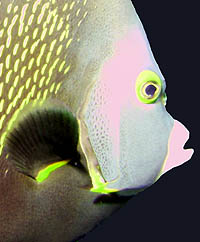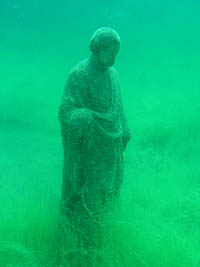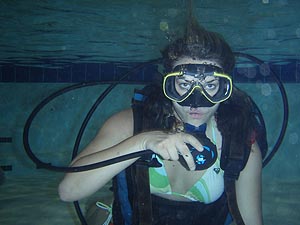« May 2007 | Main | July 2007 »
June 14, 2007
Underwater Photography Explored
More years ago than I'd like to admit, I took my first real photography class while in college. I learned a lot, took a lot of pictures, even did my own darkroom work using black and white! It was quite an exciting experience, and now that excitement has transferred over to digital photography.
My old airbrush is covered in dust, now. The icon for Adobe Photoshop has a shortcut on my desktop. Film has been replaced with memory cards of different shapes, sizes and storage space. Digital cameras are priced well within reason, and new ones come out daily, making digital photography easier, better, quicker and more convenient than a film photographer could ever dream of!
Many people say that George Eastmann invented the camera back in 1888, but photographic images date back even centuries before then. Alexander Wolcott applied for and received the first American patent in photography in 1840 for his camera. But no matter who actually invented the camera, I'm sure they would totally flip if they could see what their creation has evolved into!
Cameras, film, patents, memory ... This isn't what I intend to write about, but it brings up many thoughts to ponder.
I LOVE photography. It's challenging to me. My depth perception is off, due to the difference in focal length of my eyes, so it's almost like I have an advantage in this two dimensional medium.
 What truly presents a challenge is handling and successfully using a camera underwater. For years, the likes of waterproof Nikonos cameras have been in the hands of professional and amateur photographers alike. And, for years photographers have been baffled with the differences a photographer faces by shooting pictures underwater.
What truly presents a challenge is handling and successfully using a camera underwater. For years, the likes of waterproof Nikonos cameras have been in the hands of professional and amateur photographers alike. And, for years photographers have been baffled with the differences a photographer faces by shooting pictures underwater.
As a diver you know objects appear 25% larger and 25% closer, colors are absorbed by order of energy the deeper we dive. "ROY G BIV" is how many remember the order in which colors are absorbed. By 25 feet red is all but gone, at 35 orange goes, at 45 feet yellow is gone, and eventually everything looks inky purple. Indigo, actually. Indigo and gray. Blah. We've always been told lights help, and our eyes do compensate somewhat, but not enough to bring all the colors back.
Digital cameras come in all shapes and sizes, different megapixel capacity, different zoom lengths, different colors, different features, different memory cards, different batteries, different warranties; they are all different. It can be confusing which camera to purchase, but please take a few minutes and read what we have to say about the cameras we have been fortunate enough to review. Keep checking back, as we are constantly receiving new underwater camera equipment to try out and present our opinion about!
Now ... A word about actual underwater photography ... What you've been waiting for!
For all the reasons I listed above, taking photographs underwater is more challenging than on land. In addition to color absorption, refraction, distortion, and polarization, we also have to deal with depths, times, currents, surge, temperature, sunlight penetration, and most of all, our subjects ... critters! It takes a huge bucket of patience to photograph fish underwater.
Many fish have never seen the likes of humans, and they are often scared back into the safety of their homes. Take your time and be extraordinarily patient. Hover motionless whenever possible, slow your breathing down, concentrate on your subject, have your camera as ready as possible before you find something you want to photograph.
Many digital cameras automatically shut down to save battery life after a few minutes on inactivity, so be aware you might have to turn your camera back on before you take a photograph. Looking through a viewfinder, if your digital camera still has one, is more difficult because you're wearing your mask, so your eye will be farther away from the viewfinder than normal.
 Look into the viewfinder and see what all will be in the frame. Know the boundaries, and try to imagine in your mind what you want to fill the frame. Wait patiently for the critter to move into place. Relax, hover, breathe slowly, concentrate. Now, take the picture. Take another. And another. Remember, the worst thing that will happen is you might need to delete a frame or two. It's not like the days of film when you had 24 or 36 exposures and you were done! And, who knows ... You might happen to take a fabulous picture you might otherwise have missed!
Look into the viewfinder and see what all will be in the frame. Know the boundaries, and try to imagine in your mind what you want to fill the frame. Wait patiently for the critter to move into place. Relax, hover, breathe slowly, concentrate. Now, take the picture. Take another. And another. Remember, the worst thing that will happen is you might need to delete a frame or two. It's not like the days of film when you had 24 or 36 exposures and you were done! And, who knows ... You might happen to take a fabulous picture you might otherwise have missed!
Practice is important. Don't be discouraged if you don't get great results the first time you use your camera underwater. Don't get upset and delete them all right away. Take time to look at them and learn from them. Keep a journal and write down what the conditions were like, where you were, what depth you were at, and anything else that you might think is important. Everything you keep a record of will help you in the future. We write in a logbook, don't we? We refer back to it on occasion, don't we? You should for photography as well!
Adobe Photoshop, or another competent photo editing software program, is a must. Invest in a good photo editing program and use it to enhance your photos. Use editing software to crop your photos, straighten your photos, and adjust the color in your photos. Don't go overboard with the "auto" features as they often make underwater photographs look fake. Sometimes it's fun to take an out-of-focus photo and do crazy things with it like adjusting the color saturation to where it's drastically altered from its original state. Crop it. Blur it. Manipulate it. This can be fun when creating abstract art.
 Lighting is important. Digital cameras come equipped with a small built-in flash. These flashes can prove handy, especially when used with a diffuser. Diffusers help eliminate backscatter. Backscatter is the small particulate or sediment that's suspended in the water. We don't always see it with the naked eye, but the flash sees it and makes spots on the image. A diffuser will soften the backscatter and often eliminate it completely, as the light from the flash won't reflect off of it.
Lighting is important. Digital cameras come equipped with a small built-in flash. These flashes can prove handy, especially when used with a diffuser. Diffusers help eliminate backscatter. Backscatter is the small particulate or sediment that's suspended in the water. We don't always see it with the naked eye, but the flash sees it and makes spots on the image. A diffuser will soften the backscatter and often eliminate it completely, as the light from the flash won't reflect off of it.
Okay, so those were some basics about underwater photography. PLEASE feel free to contact me if you have questions I've not covered. As with most things, I'm sure I will think of more to say, and Part II will be born.
My best advice to you about underwater photography?
Do it! Take the plunge and buy as good of a camera as you can afford. Most of us travel long distances to dive in beautiful, tropical locations, so why not have memories we can keep forever!
Practice! As with any aspect of diving, the more we practice, the more comfortable we become. Underwater photography is no different! One benefit that most people discover when they take up underwater photography is their buoyancy drastically improves, their air consumption improves, and their comfort level improves!
Be patient! Good things come to those who wait, and that doesn't exclude underwater photographers, believe me! Hovering, relaxing, and being patient will bring you incredible photographic rewards!
***Note***
Please visit our gallery to see examples of my underwater photography, as well as several of my friends.
Posted by Carol at 04:14 PM | Comments (0)